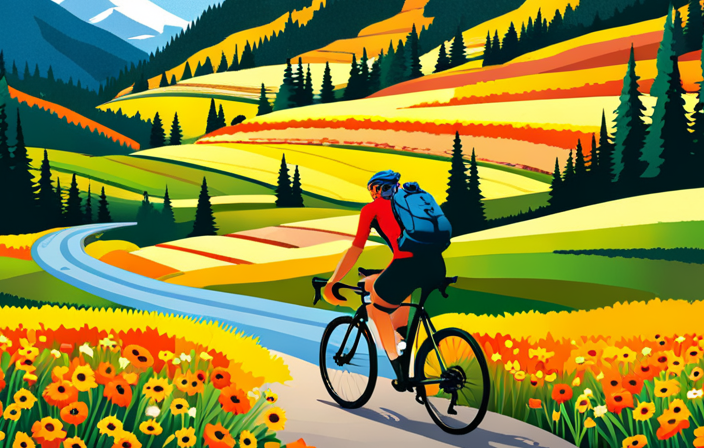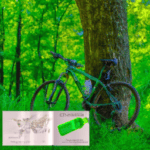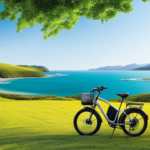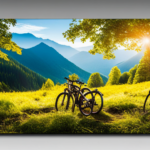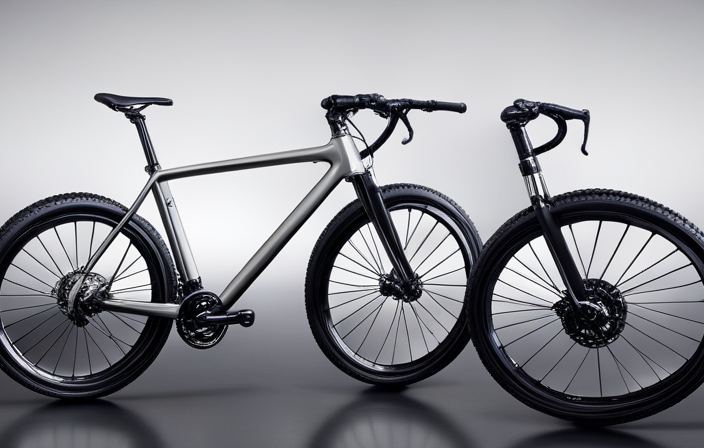Are you searching for new gravel bike routes? You’re in the right place! In this article, I will walk you through different ways to discover the ideal routes for your upcoming adventure.
By combining research, community engagement, and local expertise, you’ll uncover hidden gems in no time.
From exploring national parks to attending bike festivals, there are endless opportunities waiting for you.
So grab your helmet and get ready to pedal into an exciting world of gravel biking. Let’s dive in!
Key Takeaways
- Check with local parks and recreation departments or cycling organizations for recommended routes.
- Utilize online resources such as websites and apps that provide detailed maps and user reviews.
- Explore forums and online communities where cyclists share experiences and recommendations.
- Consider trail difficulty levels to match your skill level.
Research Local Bike Trails and Paths
You can start by researching local bike trails and paths in order to find gravel bike routes. There are several options to consider when conducting your research.
First, you can check with your local parks and recreation department or cycling organizations to see if they have any recommended routes specifically for gravel biking. They may have information on trail difficulty levels, which can be helpful in determining the right route for your skill level.
Another option is to use online resources such as websites and apps that provide detailed maps of bike trails. These resources often include user reviews and ratings, allowing you to get a sense of the trail conditions and difficulty before heading out. Additionally, some websites have forums where cyclists share their experiences and recommendations for gravel bike routes in your area.
Joining online cycling communities and forums is another great way to discover new gravel bike routes. By connecting with other riders who share your passion for gravel biking, you can learn about hidden gems that may not be well-known or advertised elsewhere. These communities often organize group rides or events on specific routes, providing an opportunity to meet fellow cyclists and explore new areas together.
By researching local bike trails and paths, you will have a wide range of options available to you when it comes to finding gravel bike routes.
Join Online Cycling Communities and Forums
By joining online cycling communities and forums, cyclists can easily discover new paths and trails suited for their gravel biking adventures. Being part of a cycling community provides numerous benefits, such as connecting with like-minded individuals who share the same passion for gravel biking. These communities often have members who are experienced in finding the best routes and can offer valuable insights and recommendations.
When participating in forums, it’s important to actively engage with other members by asking questions and sharing experiences. By doing so, you can tap into a wealth of knowledge from seasoned riders who have already explored various gravel trails. Additionally, some forums have dedicated sections specifically for route suggestions or reviews, making it easier to find information about suitable paths.
To make the most of your participation in online cycling communities and forums, here are some tips: be respectful towards others’ opinions and experiences, contribute constructively to discussions, remain open-minded to different perspectives, and express gratitude when receiving helpful advice.
Transitioning into the subsequent section about using cycling apps and websites: Once you’ve tapped into the knowledge base of online cycling communities, another useful tool for discovering gravel bike routes is through the use of dedicated cycling apps and websites.
Use Cycling Apps and Websites
Explore various cycling apps and websites to easily discover new paths and trails suited for your gravel biking adventures. These platforms provide a wealth of information and features that can enhance your cycling experience.
Here are three key features you should look for in cycling apps:
-
Route Planning: Many cycling apps allow you to plan your own routes by selecting specific criteria such as distance, elevation, or terrain type. This feature is particularly helpful when searching for gravel bike routes as it ensures you find paths suitable for off-road riding.
-
GPS Navigation: Cycling apps with built-in GPS navigation guide you along the chosen route, giving turn-by-turn directions and ensuring you stay on track. This is especially useful when exploring unfamiliar areas or venturing into remote locations.
-
Community Integration: Some apps have a strong online community where cyclists can share their favorite gravel bike routes, exchange tips, and organize group rides. Being part of these communities provides an invaluable resource for finding hidden gems and connecting with like-minded cyclists.
In addition to cycling apps, there are several websites dedicated to gravel biking that offer comprehensive route databases, user reviews, and detailed trail descriptions. Some popular websites include Ride with GPS, Trailforks, and Gravelmap.
By utilizing these resources effectively, you will be able to uncover exciting new gravel bike routes tailored to your preferences. Once armed with this knowledge from the digital realm, it’s time to consult local bike shops who can provide additional insight into the best trails in your area without compromising safety or enjoyment.
Consult Local Bike Shops
Once armed with the knowledge from the digital realm, it’s time to head to your local bike shop for additional insight into the best gravel bike routes in your area without compromising safety or enjoyment.
Local bike shops are a treasure trove of information when it comes to finding the perfect trails that suit your preferences and skill level.
One great way to tap into this wealth of knowledge is by joining local cycling clubs. These clubs often have experienced riders who are familiar with all the hidden gems in your area. They can provide valuable advice on which routes are best for gravel biking and offer tips on how to navigate them safely.
Another option is to simply talk directly to experienced riders at your local bike shop. These individuals have likely explored numerous gravel routes themselves and can give you personalized recommendations based on their own experiences. Whether you’re looking for a challenging trail or a leisurely ride, they will be able to point you in the right direction.
By consulting with local bike shops, joining cycling clubs, and talking to experienced riders, you’ll gain insider information about the best gravel bike routes in your area. Once armed with these insights, you’ll be ready to explore national and state parks where nature’s beauty awaits.
Explore National and State Parks
To fully immerse yourself in nature’s beauty, venture out to national and state parks where breathtaking scenery and exhilarating trails await your exploration. When it comes to gravel bike routes, these parks offer a diverse range of options that cater to every level of rider.
Explore Coastal Trails:
- Picture yourself cycling along the rugged coastline, with waves crashing against the rocks and seagulls soaring overhead. Coastal trails provide a unique experience, combining the thrill of off-road biking with stunning ocean views.
- Feel the cool sea breeze as you pedal through sandy dunes, passing by vibrant beach vegetation and spotting seabirds nesting in their natural habitats.
Navigate Mountain Routes:
- Embark on an epic adventure through mountainous terrain, where challenging climbs reward you with jaw-dropping panoramic vistas. The steep ascents and descents will test your skills and push your limits.
- Immerse yourself in dense forests as you navigate narrow dirt paths surrounded by towering trees. Listen to the sounds of birds chirping and water trickling down rocky streams.
By exploring national and state parks, you not only get to enjoy fantastic gravel bike routes but also contribute to conservation efforts through park fees that support habitat preservation. Once you’ve experienced the wonders of nature on your bike, it’s time to take it up a notch by joining group rides and events for even more thrilling adventures.
Join Group Rides and Events
Joining group rides and events allows you to connect with fellow cyclists and share in the excitement of thrilling adventures. It’s a great way to improve your gravel biking skills, learn from experienced riders, and discover new routes.
Group dynamics play an important role in these rides, as riding in a pack requires good communication and coordination. Learning how to ride closely behind other riders without causing accidents is crucial. You’ll need to understand hand signals, verbal cues, and be aware of your surroundings at all times.
Additionally, training for group rides is essential to ensure you can keep up with the pace and distance. Increase your endurance by gradually increasing your mileage and incorporating interval training into your routine. Practice riding in different terrains to prepare for various conditions you may encounter during group rides.
Remember that safety should always be a priority when participating in events or joining group rides.
Asking for recommendations from other cyclists can also be helpful when searching for gravel bike routes that are suitable for group rides or events where you can meet like-minded individuals who share the same passion for cycling.
Ask for Recommendations from Other Cyclists
Asking fellow cyclists for recommendations can provide valuable insights into great group rides and events in your area. When it comes to finding gravel bike routes, other riders can be an excellent source of information. They may have already discovered their favorite gravel bike routes in the area and can share their experiences with you. By asking for recommendations, you can learn about hidden gem gravel routes that you might not have discovered otherwise.
To get started, reach out to local cycling clubs or online forums dedicated to gravel biking. These communities are filled with passionate riders who love sharing their knowledge and experiences. Ask them about their favorite gravel bike routes in the area and any tips they have for finding hidden gems. You’ll likely receive a wealth of suggestions ranging from scenic countryside paths to challenging off-road trails.
Furthermore, when chatting with fellow cyclists, don’t forget to inquire about upcoming group rides or events centered around gravel biking. They might know of organized rides or races where you can join like-minded individuals and explore new routes together.
By seeking recommendations from other cyclists, you tap into a network of experienced riders who can guide you towards amazing gravel adventures. Once armed with these suggestions, it’s time to utilize GPS and navigation systems to make the most of these recommended routes seamlessly.
Utilize GPS and Navigation Systems
Once you have gathered recommendations from other cyclists, it’s time to make the most of your gravel adventures by utilizing GPS and navigation systems. These tools can greatly enhance your riding experience by providing accurate directions and ensuring that you stay on track. One of the main benefits of using GPS is that it allows you to explore new routes with confidence. You can easily input a destination or choose from pre-loaded routes, and the system will guide you turn-by-turn, eliminating any guesswork. Additionally, some GPS devices offer features such as route planning and tracking, allowing you to create and analyze your own routes.
To further emphasize the importance of using GPS and navigation systems for gravel biking, consider the following table:
| Benefits of Using GPS | Navigation Systems Tips |
|---|---|
| Accurate Directions | Plan Routes Ahead |
| Explore New Routes | Use Offline Maps |
| Route Planning | Follow Cue Sheets |
By taking advantage of these benefits and following these tips, you can ensure a smooth and enjoyable gravel biking experience. And if you’re looking for more resources to discover exciting gravel bike routes, be sure to follow gravel bike blogs and social media pages. These platforms often provide valuable insights, trail recommendations, and updates about upcoming events in the gravel biking community. It’s a great way to stay connected with like-minded riders and continue exploring new paths.
Follow Gravel Bike Blogs and Social Media Pages
To stay connected with the gravel biking community and discover exciting new paths, make sure you follow gravel bike blogs and social media pages. These platforms provide a wealth of information on popular routes, hidden gems, and insider tips from experienced riders. By following gravel bike blogs, you can gain access to comprehensive route descriptions, including distance, elevation, and difficulty level. These blogs often feature stunning photos and personal anecdotes that bring the routes to life.
Additionally, joining online cycling communities allows you to connect with fellow gravel bikers who share their favorite routes and offer advice on navigation. These communities are a great place to ask questions, seek recommendations for specific locations or terrains, and even find riding partners.
By following gravel bike blogs and joining online cycling communities, you’ll be able to tap into a vast network of knowledge and expertise within the gravel biking community. You’ll never run out of inspiration for your next adventure!
Now that we’ve explored how to utilize GPS systems and the importance of following gravel bike blogs and social media pages in finding great routes, let’s move on to another helpful tool: checking out Strava segment heatmaps.
Check Out Strava Segment Heatmaps
One useful tool for exploring new paths is checking out Strava segment heatmaps. Strava is a popular social fitness app that allows users to track their activities and share them with others. One of the features it offers is the ability to analyze segments of routes that have been recorded by other users. By using the segment analysis feature, you can see which routes are popular among cyclists in your area.
Here are three reasons why checking out Strava segment heatmaps can be beneficial:
1) Discover popular cycling routes: The heatmaps show where most cyclists ride, indicating popular areas for gravel biking. This allows you to find well-traveled paths that have already been tested by others.
2) Determine route difficulty: The heatmap also provides information on the intensity of each segment, helping you choose routes that match your skill level and preferences.
3) Uncover hidden gems: In addition to popular cycling routes, the heatmap may reveal lesser-known trails or scenic spots that you might not have discovered otherwise.
By utilizing the Strava segment analysis feature, you can uncover a wealth of information about gravel bike routes in your area. Once you have explored this option, it’s time to consider scenic routes and landmarks as part of your gravel biking adventure.
Consider Scenic Routes and Landmarks
When planning your gravel biking adventure, don’t forget to take into account the scenic routes and landmarks that you can explore along the way. Not only will these routes provide breathtaking views for scenic photography, but they may also lead you to hidden gems that are off the beaten path. To help you get started, here is a table showcasing some of the most picturesque gravel bike routes and their corresponding landmarks:
| Route Name | Landmark |
|---|---|
| Coastal Trail | Stunning ocean vistas |
| Mountain Pass | Majestic mountain peaks |
| Forest Loop | Tranquil woodland trails |
| River Run | Serene riverside paths |
By incorporating these scenic routes into your gravel bike adventure, you’ll have plenty of opportunities to capture beautiful photos and discover unique spots that many others may overlook. So why not add a little extra excitement to your journey by exploring these hidden gems? After all, there’s nothing quite like stumbling upon a stunning view or a charming landmark in the midst of an exhilarating ride.
Now that you’ve considered the importance of scenic routes and landmarks in planning your gravel bike adventure, it’s time to move on to the next step: asking for suggestions from local tourism offices.
Ask for Suggestions from Local Tourism Offices
Consider reaching out to local tourism offices for suggestions on the best places to explore and landmarks to visit during your gravel biking adventure. Interacting with local communities and joining group rides can provide valuable insights into popular gravel bike routes in the area. Local tourism offices often have detailed maps and brochures that highlight scenic routes, points of interest, and recommended stops along the way.
Another great way to discover new gravel bike routes is by participating in gravel bike festivals and races. These events attract avid gravel bikers from all over, offering the opportunity to connect with fellow riders who can share their favorite routes and hidden gems. Additionally, these events often showcase unique trails or roads that are specifically chosen for their challenging terrain or breathtaking views.
Exploring rural and countryside areas is a natural transition from seeking suggestions from local tourism offices. These less-traveled paths not only offer a peaceful escape from busy city streets but also present stunning landscapes filled with rolling hills, serene lakes, and picturesque farmlands. Riding through these areas allows you to immerse yourself in nature while enjoying the thrill of navigating diverse terrains.
By incorporating these strategies into your search for gravel bike routes, you’ll be able to find hidden gems that truly capture the essence of your destination. So saddle up and get ready to embark on an unforgettable journey through beautiful landscapes!
Explore Rural and Countryside Areas
To fully immerse yourself in the natural beauty of your destination, why not venture into rural and countryside areas during your gravel biking adventure? Exploring these off-the-beaten-path locations will not only provide you with stunning views but also allow you to discover hidden gems that are often overlooked by tourists. Here are some ways to make the most out of your journey:
-
Explore vineyards and wineries: Many rural areas are home to picturesque vineyards and wineries. Take a break from biking and indulge in a wine tasting experience while enjoying the scenic surroundings. Not only will you get a chance to sample delicious wines, but you’ll also learn about the local wine-making process.
-
Discover hidden lakes and reservoirs: Rural areas are often dotted with serene lakes and reservoirs that offer a peaceful retreat from the hustle and bustle of city life. Pack a picnic lunch, take a dip in the refreshing waters, or simply relax on the shore while taking in the breathtaking views.
By exploring these rural and countryside areas, you’ll not only have an unforgettable gravel biking experience but also get a taste of the local culture and natural wonders. After immersing yourself in nature’s beauty, it’s time to gear up for some thrilling adventures at gravel bike festivals and races.
(Note: Transition sentence) Once you’ve soaked up all that rural charm, attending gravel bike festivals and races will add excitement to your journey.
Attend Gravel Bike Festivals and Races
Once you’ve immersed yourself in the beauty of rural and countryside areas, attending gravel bike festivals and races will add a thrilling element to your journey. Gravel bike festivals offer a unique opportunity to connect with fellow cyclists, explore new routes, and challenge yourself in a competitive environment. These events often feature various race distances to accommodate riders of all levels, from beginners to seasoned gravel enthusiasts.
To give you an idea of what you can expect at gravel bike festivals and races, here is a visual representation:
| Benefits | Highlights | |
|---|---|---|
| 1 | Community camaraderie | Scenic course options |
| 2 | Networking opportunities | Vendor expos |
| 3 | Skill development | Post-race celebrations |
| 4 | Competitive spirit | Prizes and giveaways |
Participating in these events not only allows you to push your limits but also provides an excellent chance to learn from experienced riders. You can gain valuable insights about techniques, training strategies, and equipment choices. Additionally, gravel bike festivals often include vendor expos where you can discover the latest gear and accessories.
Transitioning into the subsequent section about ‘take safety precautions and plan ahead,’ it’s crucial to prioritize your well-being during these exciting events.
Take Safety Precautions and Plan Ahead
Make sure to prioritize your safety and plan ahead when attending gravel bike festivals and races. Here are four important tips to ensure a smooth and safe experience:
-
Bike Maintenance: Before hitting the gravel, it’s crucial to check your bike for any mechanical issues. Inspect the tires, brakes, gears, and chain to ensure they are in good working condition. Consider getting a professional tune-up if needed.
-
Emergency Preparedness: Always be prepared for the unexpected. Carry essential items such as a first aid kit, spare tubes, tire levers, multitool, pump or CO2 inflator, and plenty of water. Familiarize yourself with basic bike repairs so you can handle minor issues on the trail.
-
Route Research: Prioritize planning your route in advance by studying maps or using GPS navigation tools specifically designed for off-road cycling routes. Look for designated gravel paths or trails that suit your skill level and desired distance.
-
Safety Gear: Wear appropriate safety gear including a well-fitted helmet, gloves, sunglasses to protect against debris, and comfortable clothing suitable for weather conditions.
By following these guidelines and taking necessary precautions like regular bike maintenance and emergency preparedness measures, you can enjoy gravel bike festivals and races while ensuring your safety throughout the journey.
Frequently Asked Questions
Are there any specific safety precautions I should take when riding on gravel bike routes?
When riding on gravel bike routes, it’s important to take certain safety precautions. Here are some tips for staying safe on these types of routes.
Firstly, make sure you have the right tires with appropriate tread for gravel roads.
Maintain a consistent speed and avoid sudden braking or turning, as gravel can be slippery.
Keep a firm grip on the handlebars and always be aware of your surroundings.
Lastly, wear appropriate protective gear like a helmet and reflective clothing to increase visibility.
How can I plan ahead and prepare for a gravel bike ride?
When planning for a gravel bike ride, I start by researching the route and checking the weather forecast. This helps me choose appropriate gear such as a helmet, gloves, and padded shorts.
I also make sure to pack essential items like spare tubes, tire levers, and a multi-tool for any repairs that may be needed along the way.
Additionally, I plan my hydration and nutrition needs based on the distance and intensity of the ride.
Are there any specific rural or countryside areas that are known for their gravel bike routes?
Yes, there are specific rural areas that are known for their popular gravel bike routes. One example is the countryside region of Tuscany in Italy, which offers a variety of scenic and challenging gravel routes.
Another option is Vermont in the United States, where rural roads wind through picturesque farmland and forests. These areas attract gravel biking enthusiasts due to their beautiful landscapes and well-maintained gravel roads perfect for cycling adventures.
Can you recommend any gravel bike festivals or races that I can attend?
Sure!
I recently attended the Gravel Grinder Festival, and let me tell you, it was a blast. Picture this: riders of all levels coming together to conquer challenging gravel courses. And the best part? There was more than just biking. There were food trucks, live music, and an incredible atmosphere. It truly felt like being part of a vibrant community that shares a love for gravel biking.
But festivals aren’t the only way to get your gravel fix. Throughout the year, there are numerous gravel bike races happening. Some of the most popular ones include the Dirty Kanza and the Crusher in the Tushar. These events not only offer thrilling competition but also provide an opportunity to connect with fellow gravel enthusiasts. It’s a chance to push yourself and be part of something bigger.
Are there any specific landmarks or scenic routes that I should consider when choosing a gravel bike route?
When choosing a gravel bike route, it’s important to consider scenic landmarks and popular routes. These can enhance your riding experience and provide picturesque views along the way.
Look for routes that pass by natural wonders like waterfalls, mountains, or lakes. Consider iconic landmarks in your area that you may want to explore on your bike.
Researching popular routes online or asking fellow cyclists for recommendations can also help you discover the best options in your area.
Conclusion
In conclusion, finding gravel bike routes doesn’t have to be a daunting task. By utilizing various resources such as online communities, cycling apps, local bike shops, and tourism offices, you can discover hidden gems for your next adventure.
Don’t be afraid to explore rural areas or attend gravel bike festivals and races to experience the thrill of off-road cycling. Just remember to plan ahead and prioritize safety while embarking on your epic gravel biking journey.
Happy riding! Remember, the world is your oyster…or should I say, the endless possibilities of gravel bike routes are as vast as the universe itself!
